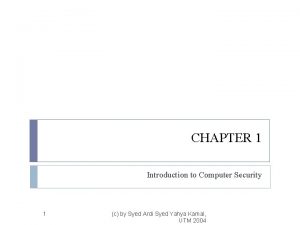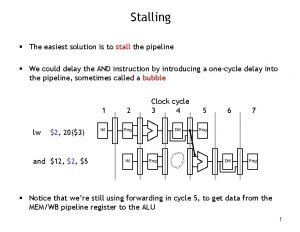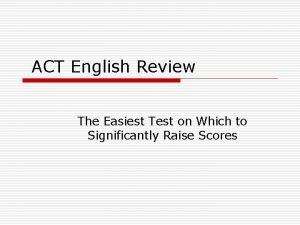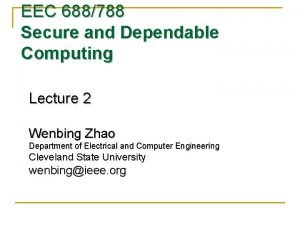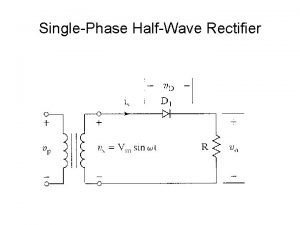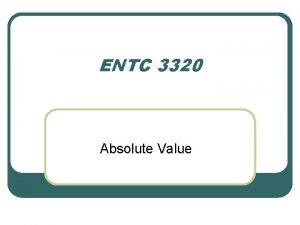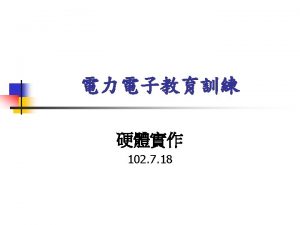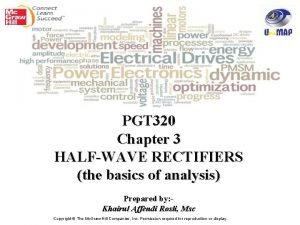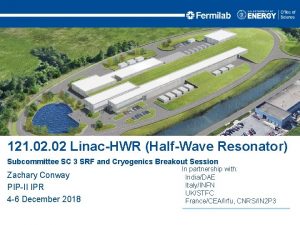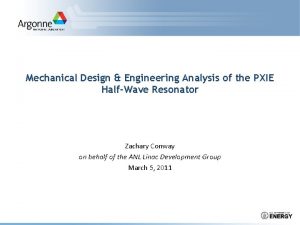Halfwave Rectifier Halfwave Rectifier The easiest rectifier to














- Slides: 14

Half-wave Rectifier

Half-wave Rectifier ØThe easiest rectifier to understand is the half wave rectifier. ØA simple half-wave rectifier using an ideal diode and a load is shown in Figure 1. ØCircuit operation Let’s look at the operation of this single diode rectifier when connected across an alternating voltage source vs. Ø Since the diode only conducts when the anode is positive with respect to the cathode, current will flow only during the positive half cycle of the input voltage.

ØThe supply voltage is given by: Vs = Vm sin(wt)…………… (1) where w= 2 ∏ f = 2 ∏ / T is the angular frequency in rad/s. ØWe are interested in obtaining DC voltage across the “load resistance” RL. ØDuring the positive half cycle of the source, the ideal diode is forward biased and operates as a closed switch. ØThe source voltage is directly connected across the load. During the negative half cycle, the diode is reverse biased and acts as an open switch. ØThe source voltage is disconnected from the load. As no current flows through the load, the load voltage Vo is zero.

ØBoth the load voltage and current are of one polarity and hence said to be rectified. ØThe waveforms for source voltage VS and output voltage Vo are shown in figure 2.

ØWe notice that the output voltage varies between the peak voltage Vm and zero in each cycle. ØThis variation is called “ripple”, and the corresponding voltage is called the peak-to-peak ripple voltage, Vp-p. Average load voltage and current Ø If a DC voltmeter is connected to measure the output voltage of the half-wave rectifier (i. e. , across the load resistance), the reading obtained would be the average load voltage Vave, also called the DC output voltage. ØThe meter averages out the pulses and displays this average. ØVave=Vm/∏

ØThe output voltage waveform and average voltage are shown in figure 3. Average Load Current Ø Just as we can convert a peak voltage to average voltage, we can also convert a peak current to an average current. The value of the average load current is the value that would be measured by a DC ammeter. IL = Vave/RL…………………. . 3 where IL is the average current passing through the load resistance. Peak Inverse Voltage ØThe maximum amount of reverse bias that a diode will be exposed to is called the peak inverse voltage or PIV. For the half wave rectifier, the value of PIV is: PIV=Vm………………… 4

Half-wave Rectifier with Capacitor Filter ØThe capacitor is the most basic filter type and is the most commonly used. ØThe half-wave rectifier for power supply application is shown below. Ø A capacitor filter is connected in parallel with the load. ØThe rectifier circuit is supplied from a transformer. Circuit operation ØThe operation of this circuit during positive half cycle of the source voltage is shown in figure 4. ØDuring the positive half cycle, diode D 1 will conduct, and the capacitor charges rapidly.

ØAs the input starts to go negative, D 1 turns off, and the capacitor will slowly discharge through the load (figure 5).

ØUsing the previous half wave rectifier as an example, figure 6 examines what is happening with our filter (a)Unfiltered output from the half wave rectifier (a)When the next pulse does arrive, it charges the capacitor back to full charge as shown on the right. The thick line shows the charge – discharge waveform at the capacitor. (a)The load sees a reasonably constant DC voltage now, with a ripple voltage on top of it.

ØThe operation can be analyzed in detail using figure 7. ØDuring each positive half cycle, the capacitor charges during the interval t 1 to t 2. ØDuring this interval, the diode will be forward biased. ØDue to this charging, the voltage across the capacitor Vo will be equal to the AC peak voltage Vm on the secondary side of the transformer at t 2 (assuming diode forward voltage drop is zero). ØThe capacitor will supply current to load resistor RL during time interval t 2 to t 3.

ØDuring this interval, diode will be reverse biased since the AC voltage is less than the output voltage vo. Due to the large energy stored in the capacitor, the capacitor voltage will not reduce much during t 2 to t 3, and the voltage Vo will remain close to the peak value. As can be seen, addition of the capacitor results in much better quality output voltage. Average load voltage In practical applications, a very large capacitor is used so that the output voltage is close to the peak value. The average voltage (also called DC output voltage) across the load can therefore be approximated to: Vave =Vm ……………. . (1)

Calculation of capacitance ØThe voltage waveforms show a small AC component called “ripple” present in the output voltage. ØThis ripple can be minimized by choosing the largest capacitance value that is practical. The capacitor is typically “electrolytic” type, and is very large (several hundreds or even thousands of microfarads). ØWe can calculate the required value of the filter capacitor as follows. The charge removed from the capacitor during the discharge cycle (i. e. , t 2 to t 3) is: ∆ Q = ILT ………………. (2) ØWhere IL is the average load current and T is the period of the AC voltage. As the interval t 1 to t 2 is very small, the discharge time can be approximated to T.

ØIf Vp-p is the peak-to-peak ripple voltage, and C is the capacitance, the charge removed from the capacitor can also be expressed as: ∆ Q = Vp-p C …………. . (3) ØFrom these two equations, capacitance C can be calculated as: C= I LT/ V p -p Farads. , ………………. (4)

Thank You
 Phonological awareness skills from easiest to hardest
Phonological awareness skills from easiest to hardest Distinguish among vulnerability threat and control
Distinguish among vulnerability threat and control What is the easiest exam board
What is the easiest exam board Solution
Solution The easiest test
The easiest test Making silicone toys
Making silicone toys Easiest demon
Easiest demon Principle of easiest penetration
Principle of easiest penetration Full wave rectifier vs half wave rectifier
Full wave rectifier vs half wave rectifier Fullwave rectification
Fullwave rectification Thế nào là mạng điện lắp đặt kiểu nổi
Thế nào là mạng điện lắp đặt kiểu nổi Hát kết hợp bộ gõ cơ thể
Hát kết hợp bộ gõ cơ thể Dot
Dot Vẽ hình chiếu đứng bằng cạnh của vật thể
Vẽ hình chiếu đứng bằng cạnh của vật thể độ dài liên kết
độ dài liên kết

